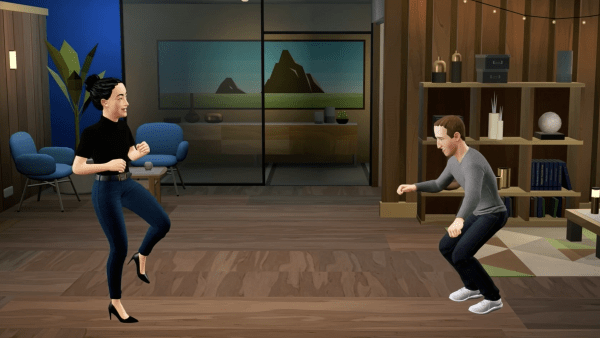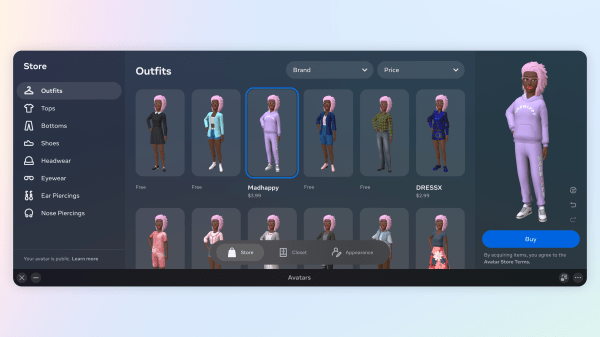
This story is part of a group of stories called

Uncovering and explaining how our digital world is changing — and changing us.
Mark Zuckerberg announced that his company will be taking a major step to making its virtual reality metaverse avatars more lifelike: by giving them legs.
Since Zuckerberg unveiled his grand metaverse ambitions nearly a year ago — betting his company’s future on the idea that the next era of the internet will depend on virtual and augmented reality — many have criticized the tech giant’s plans as unrealistic, and mocked the fact that the 3D digital avatars meant to mimic our bodies currently lack lower limbs.
Zuckerberg himself was ridiculed online when he enthusiastically shared a screenshot of his avatar on his Facebook page in August.
Soon after, Zuckerberg promised “major graphic updates” coming to Meta’s avatars, and he delivered that update at Tuesday’s annual Meta Connect developer event, when he announced that legs are coming to the metaverse.
“I know you’ve been waiting for this. Everyone has been waiting for this,” said a visually improved avatar version of Zuckerberg in Tuesday’s presentation. “But seriously, legs are hard, which is why other virtual reality systems don’t have them either.”
The fact that now Zuckerberg is prioritizing legs in the metaverse shows how much public perception of the metaverse matters, and that the toughest challenge to Meta succeeding may be solving the technology’s seemingly simple (although technically complex) visual problems. Meta needs to show that it’s in touch with reality, even as it builds an alternate universe. It’s a particularly crucial moment for the company to get people excited about the metaverse, as the tech giant’s stock has been steeply declining for the past year and many of its employees have reportedly been doubting the company’s major AR/VR bets.

The reason it’s been so difficult for Meta to recreate our legs in the metaverse is that currently, its AR/VR headsets only track upper-body movements like our hands and facial gestures. So the company currently has no way to know what our legs are doing when we strap on one of its headsets.
To be clear, avatars in Meta’s AR/VR products today, including the new high-end Quest Pro headset it just released, still don’t have legs. The company says it’s bringing legs to its social environment, Horizon Worlds, first, and then will expand to other products. But it’s unclear when exactly these legs will come. And it remains a major technical challenge to solve.
Zuckerberg said Meta will use predictive AI models to guess what our legs are doing based on our upper-body movements. No other popular AR/VR hardware maker has been able to do this yet. But it isn’t out of the realm of possibility for Meta, a company with one of the largest staffs of engineers in the world that is spending $10 billion a year on metaverse projects alone.
“With standalone virtual reality headsets, understanding your leg position is surprisingly difficult because of occlusion,” Zuckerberg explained about the technical challenge in the presentation. “So if your legs are under a desk or if your arms block your view of them, then your headset can’t see them directly, and you need to build an AI model to predict your whole body position.”
Meta says it’s not only improving avatars by adding legs, but that it will refine its visual graphics more broadly. The company said on Tuesday that its new high-end headset, the Quest Pro, has inward-facing head sensors to be able to track eye movements and facial expressions, allowing more lifelike expressions on avatars. A spokesperson also said that the company is adding “incremental updates to style and appearance of Meta Avatars over time,” including expressions as well as “depth,” “shading,” and more clothing and accessory options.
To be fair, part of what might have underwhelmed some critics about Meta’s AR/VR products so far is what gets lost in translation from the virtual to physical world. Meta’s AR/VR experiences feel more lifelike and impressive when you’re actually strapped into a headset, immersed in a 3D AR/VR world, than when you’re looking at a 2D screenshot of that environment on a computer screen.

It’s still key that Zuckerberg and his team figure out how to solve the avatar leg problem — and how to improve avatar graphics overall — quickly. Recent reporting from The Verge and the New York Times suggests that Meta is struggling to get its own employees spending time as avatars in its social VR/AR environment, Horizon Worlds. And while Meta announced a key partnership with fellow tech giant and VR/AR hardware rival Microsoft on October 11 to bring its popular software like Office 365 to Meta’s Quest Pro device, Meta has major competition looming on the horizon from Apple — which is rumored to be working on its own headset.
If Meta can’t figure out something as outwardly simple as legs, and convince the public that the metaverse is worth diving into, the future of the company could be at risk. Which is why it’s smart that Zuckerberg gave in to the trolls today, and promised to give the people what they want — no matter how technically complicated that might be.
Our goal this month
Now is not the time for paywalls. Now is the time to point out what’s hidden in plain sight (for instance, the hundreds of election deniers on ballots across the country), clearly explain the answers to voters’ questions, and give people the tools they need to be active participants in America’s democracy. Reader gifts help keep our well-sourced, research-driven explanatory journalism free for everyone. By the end of September, we’re aiming to add 5,000 new financial contributors to our community of Vox supporters. Will you help us reach our goal by making a gift today?
Sourse: vox.com